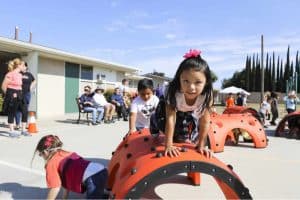Message from our Parent Association
First off, we would like to say thank you to all of the families who attended our first TLCCA meeting and Parent Workshop of the year. Dr. Tunney offered many ways to be involved, including volunteering during the school day, joining our handy club and more! You will have another opportunity to sign up at Back to School night next Wednesday on September 18th at 6pm.
Our TLCCA (TLC Community Association) President Haydee Lares offered opportunities in participating with Fundraising, event committees and more as well and she will also be there at Back to School night.
To be conducive to our inclusivity, the meeting was conducted in English and Spanish. Some families were asking about resources and ways to talk to their own children about making friends and the diversity at TLC so we have compiled a few references. Here is a few things to keep in mind:
- Don’t define the child by his or her impairment. He is not spastic, he has spastic Cerebral Palsy. She is not a disabled child, she is a child with a disability.
- Don’t identify the child by the impairment or disability, unless it is relevant. Example: “The individual using the wheelchair…” is only deemed appropriate when the use of the wheelchair is relevant to the conversation.
- Don’t use slang to label a person. He is not a “cripple,” “retarded,” “disabled,” “impaired,” “spastic,” or “special ed.” He is simply a child with special needs.
- Keep abreast of and use updated terminology. Example: She is not “wheelchair-bound,” “physically-handicapped,” “differently-abled,” or “physically challenged.” Instead, “She uses a wheelchair,” “she has a disability,” and “she has a physical impairment.”
- Eliminate negative tone as it is hurtful. For example, he is not “special ed,” he participates in the special education program.
- Eliminate disrespectful slang and words that imply victimization. For example, he is not a victim, unfortunate, crippled, sufferer, stricken, or invalid. He simply has impairment.
- Become familiar with the level of impairment. Example:
- A person with total hearing loss is considered a person who is without hearing.
- A person with partial hearing loss is referred to as a person with hearing impairment.
- A person with total sight loss is not referred to as “a blind person,” but as “a person who is blind.”
- A person with a varying degree of sight — a person who can see but is not considered legally blind, for example — is a person with vision impairment.
- A person who displays trouble speaking, uses voice prosthesis, or appears to stutter is “a person with speech impairment.”
*Note: There are many of lines of thought on this matter and there is no “right way” to speak, however these general guides can be useful and we encourage you to get to know families who may have more individual insight.
Books about Inclusion : https://adayinourshoes.com/kids-books-inclusion/
Full Article: https://www.cerebralpalsy.org/information/disability/etiquette
_____
- No definir a un niño por su condición (ejemplo) No es paralitico, tiene parálisis cerebral. No es un discapacitado, es un niño que tiene una discapacidad.
- No identificar al niño por su condición al menos que se relevante, por ejemplo: “ El individuo en silla de ruedas “solo es apropiado cuando el uso de la silla de ruedas sea relevante para la conversación
- No usar palabras despectivas como “lisiado” “retrasado” “discapacitado” etc …..Es solo un niño con necesidades especiales.
- Usar la terminología correcta por ejemplo “Usa una silla de Ruedas” “Tiene una discapacidad”
- Eliminar el tono negativo no es un niño “special ed” simplemente es un niño que participa en un programa de educación especial.
- Eliminar el uso de palabras que conllevan a la victimización tales cómo “está enfermo” “padece de…” “sufre de” etc Es simplemente una persona con una condición, no tiene una enfermedad.
- Familiarizarse con el nivel de la condición del individuo Ejemplos:
- Una persona con pérdida auditiva total es considerada una persona que no puede escuchar
- Una persona que tiene una pérdida auditiva parcial, se le considera una persona con un impedimento auditivo
- Una persona que tiene pérdida total de la visión no es “un ciego” es una persona que no puede ver
- En resumen no definir a una persona por su condición, se debe validar que esa persona primero que nada es un individuo. Y ese individuo tiene alguna condición.

